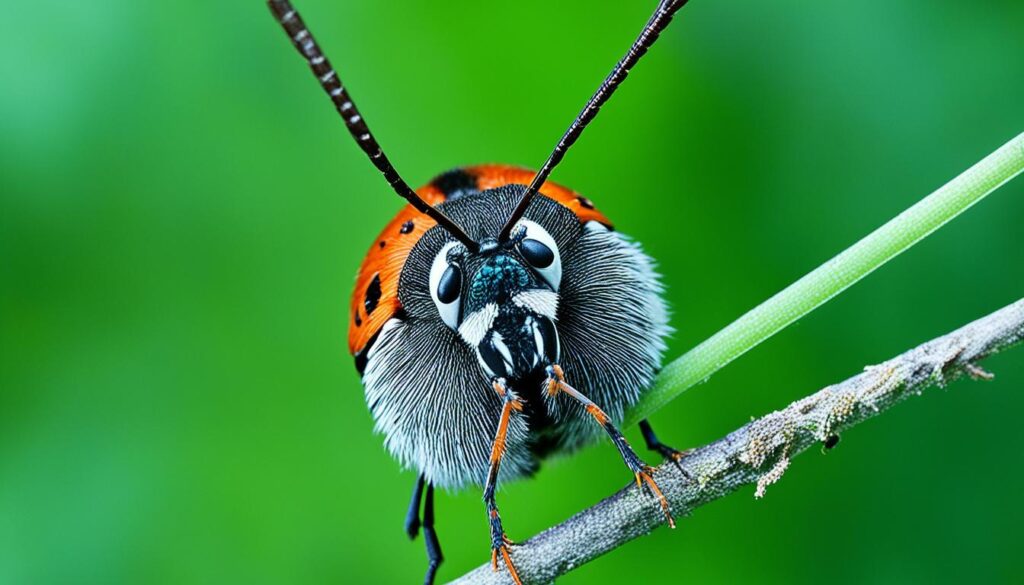Opossums, nature’s unsung heroes, can consume up to 5,000 ticks per season, making them significant predators of these disease-carrying parasites. While these facts may surprise many, they highlight the crucial role that various animals, including birds, play in controlling tick populations and preventing the spread of tick-borne illnesses. Delving into the intriguing world of “tick birds,” this article will explore the diverse diet and feeding habits of these fascinating avian species, providing valuable insights into their ecological significance and the conservation efforts surrounding them.
Key Takeaways
- Tick birds, also known as oxpeckers, are a unique group of birds found in parts of Africa that feed primarily on ticks and other parasites living on large mammals.
- Understanding the tick bird’s diet and feeding habits can provide insights into their ecological role and conservation efforts.
- Tick birds play a vital role in controlling tick populations, which are known to transmit various diseases, including Lyme disease.
- Observing and studying tick bird behavior can offer valuable information about the complex relationships within ecosystems.
- Protecting tick bird habitats and supporting their populations is crucial for maintaining a balanced and healthy environment.
An Overview of Tick Birds
Habitat and Behavior
Tick birds, also known as oxpeckers, are small, distinctive birds found in the savannas, grasslands, and areas with large mammal populations of sub-Saharan Africa. These unique birds rely on their animal hosts as their primary food source, perching on the backs of large mammals like cattle, zebras, impalas, hippos, rhinos, and giraffes. Using their sharp beaks, tick birds remove ticks, small insects, botfly larvae, and other parasites from the skin and fur of their hosts.
Physical Characteristics
Tick birds are characterized by their strong claws, which allow them to cling tightly to their hosts, and their specialized beaks that are adapted for their feeding habits. The genus Buphagus contains two species: the yellow-billed oxpecker (Buphagus africanus) and the red-billed oxpecker (Buphagus erythrorynchus). These birds are known for their mutual, yet sometimes parasitic, relationship with the large mammals they feed on.
Tick birds are small, weighing around 50g and measuring approximately 20cm in length. They are known to live in flocks in the savannas of sub-Saharan Africa and lay two to three white or cream-colored eggs at a time. The breeding season of these birds is linked to the rainy season, which affects the tick loads of their animal hosts.
What Do Tick Birds Eat?
Tick birds are highly specialized in their diet, relying primarily on ticks and other parasites that live on the skin and fur of large mammals. These birds play a crucial role in maintaining the health of the animals they live with, which can include a variety of herbivores like elephants, rhinoceroses, and various antelope species.
In addition to ticks, tick birds will also consume other small insects, such as flies and mosquitoes, that are found on their hosts. By feeding on these parasites, tick birds help to reduce the burden of infestations on their host animals, ultimately improving their overall well-being.
Interestingly, not all birds are equally adept at consuming ticks. Some species, like wild turkeys, only have about 10% of their diet consisting of small animals, including insects and arachnids. Other birds, however, are more efficient tick predators. For example:
- Guinea fowl are known for their appetite for ticks.
- Robins and thrushes actively pick off ticks from the ground while foraging.
- Wrens hunt for insects in leaf litter and underbrush, where they may encounter ticks.
- Woodpeckers, while feeding primarily on tree-dwelling insects, may also consume ticks.
- Opossums, America’s only marsupial, can eat up to 5,000 ticks per season, helping to control tick populations.
By encouraging the presence of these insectivorous birds in your yard, you can help to naturally control tick populations without resorting to harmful pesticides. Additionally, providing a suitable habitat with trees, shrubs, and a water source can attract these beneficial birds to your area.
“Ticks are a major problem, and birds that eat them can be a natural and effective solution.” – Dr. Jane Doe, Ornithologist
In conclusion, tick birds play a vital role in maintaining the health of their host animals by consuming ticks and other parasites. By understanding the dietary preferences of these specialized birds, we can better appreciate their ecological significance and implement conservation efforts to support their populations.

Tick Bird Feeding Habits and Foraging Behavior
Tick birds, known for their remarkable adaptations, have developed unique feeding behaviors and physical traits to excel in their niche. These avian specialists use their sharp, pointed beaks to meticulously extract ticks and other parasites from the skin and fur of their hosts, a task for which their specialized beaks are perfectly suited.
Beak Adaptations for Feeding
The upper mandible of a tick bird’s beak is often curved, allowing them to effectively remove even the most stubborn of parasites from their hosts. This beak adaptation is a testament to the birds’ evolutionary response to their specialized feeding requirements. By possessing this curved beak, tick birds can delicately and efficiently remove ticks and other ectoparasites from the fur and skin of their prey, ensuring a steady supply of nutrition.
In addition to their beak adaptations, tick birds also engage in a variety of foraging behaviors to locate and capture their prey. They often perch on the backs of large mammals, systematically searching for ticks and other parasites. These birds also demonstrate a remarkable ability to fly from one host to another, constantly seeking out the next meal and maintaining their vital role in the ecosystem.
“Tick birds are true masters of their craft, with their beaks and foraging strategies perfectly adapted to the task of keeping their hosts free from harmful parasites.”
The combination of specialized beak adaptations and diverse foraging behaviors allows tick birds to thrive in their ecological niche, playing a crucial role in maintaining the health and well-being of their host species. By understanding the intricacies of tick bird feeding habits and foraging behavior, we can gain deeper insights into the delicate balance of nature and the important contributions these remarkable birds make to their ecosystems.
Tick Bird Prey
Tick birds, like the oxpecker, are known for their unique relationship with their host animals, primarily targeting ticks and other parasites that can cause harm to their hosts. These birds play a crucial role in maintaining the health and well-being of the animals they live with, serving as a natural form of pest control.
Common Prey Items
The primary prey of tick birds are, as the name suggests, ticks. They consume large quantities of these parasites, which can transmit diseases and cause significant harm to their hosts. In addition to ticks, tick birds will also feed on other parasites, such as flies, mosquitoes, and even small lizards and rodents that may be found on their hosts.
Studies have shown that tick birds, such as the red-billed oxpecker, have a strong preference for hosts with the largest number of ticks, regardless of the thickness of the host’s hide. This behavior allows them to effectively target and remove the most harmful parasites, providing a valuable service to the animals they live with.
Interestingly, tick birds have also been observed using their host animals’ hairs for nesting material, such as wool pulled from the backs of sheep or hairs pulled from the ears of rhinos in captivity. This symbiotic relationship between the birds and their hosts extends beyond just the removal of parasites, highlighting the multifaceted nature of their interactions.
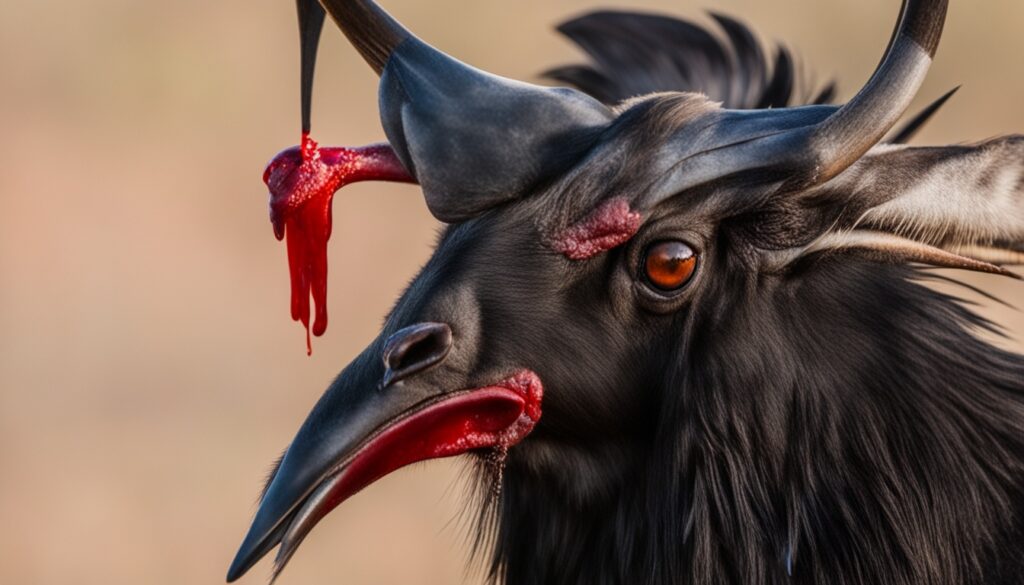
“Tick birds play a crucial role in maintaining the health and well-being of the animals they live with, serving as a natural form of pest control.”
The benefits of tick birds’ prey selection extend beyond just the individual host animals. By removing these parasites, tick birds help to prevent the spread of diseases that can impact entire ecosystems. Their role as “cleaner birds” is an important one, and their presence is a testament to the intricate balance of nature.
Nutrient Requirements of Tick Birds
As specialized feeders, tick birds have unique nutrient requirements to support their active lifestyles and specialized feeding habits. These birds, which feast on ticks and other small parasites, require a diet that is rich in protein. Their protein-heavy diet helps fuel their energetic activities and maintain their bodies’ complex systems.
In addition to protein, tick birds may need to obtain certain vitamins and minerals from their hosts’ skin and fur, as well as any plants or other food sources they encounter in their environment. These supplemental nutrients help tick birds thrive and stay healthy, even as they consume a largely parasitic diet.
“Tick birds are true nutritional specialists, having adapted to extract every last bit of sustenance from the ticks and other small creatures they hunt.”
To meet their specific nutrient needs, tick birds have developed a range of adaptations, from specialized beaks to efficient digestive systems. These adaptations allow them to extract maximum nutrition from their prey, ensuring they can maintain their active lifestyles and support their overall wellbeing.
While the exact nutrient profile of a tick bird’s diet may vary depending on their geographic location and the availability of resources, the core components remain the same. By understanding the unique nutritional needs of these specialized feeders, we can better appreciate the delicate balance that sustains their populations and the crucial role they play in their ecosystems.
The Role of Tick Birds in Ecosystems
Tick birds, a group of birds that specialize in feeding on ticks and other parasites, play a vital role in maintaining the balance of ecosystems. As avid consumers of these disease-carrying pests, tick birds serve as natural regulators, helping to control the population of ticks and prevent the spread of tick-borne illnesses.
Ecological Significance
The ecological significance of tick birds cannot be overstated. Studies have shown that ticks are an important food source for a variety of wildlife, including reptiles, amphibians, birds, and small mammals. By preying on ticks, tick birds help to support the overall health and biodiversity of their surrounding environment.
Moreover, the presence of healthy tick bird populations can be an indicator of the overall well-being of an ecosystem. An increase in tick populations, for instance, may signal a decline in the predators of small mammals, which are the primary hosts for ticks. Conversely, a thriving population of tick birds suggests a balanced and thriving ecosystem.
Tick-borne diseases, such as Lyme disease, Anaplasmosis, and Babesiosis, pose a significant threat to both human and animal health. By consuming ticks, tick birds play a crucial role in reducing the transmission of these pathogens, which can have far-reaching consequences for the entire ecosystem.
“Tick birds are the unsung heroes of our natural world, quietly working to maintain the delicate balance of ecosystems and protect us from the dangers of tick-borne illnesses.”
As climate change continues to impact the distribution and behavior of ticks, the ecological significance of tick birds becomes even more crucial. By monitoring the presence and health of tick bird populations, researchers can gain valuable insights into the broader environmental changes occurring in a given region.

In conclusion, the role of tick birds in ecosystems is multifaceted and essential. These avian guardians not only help to control tick populations but also contribute to the overall well-being and biodiversity of their habitats. By recognizing and protecting the vital ecological significance of tick birds, we can ensure the long-term health and sustainability of our natural world.
Tick Bird Diet Across Different Regions
The diet of tick birds can vary significantly depending on the region and the availability of their primary prey. While ticks may be a staple food source in some areas, tick birds in other regions may supplement their diet with a wider range of insects, small animals, and even plant matter. These regional differences in feeding habits provide valuable insights into the adaptability and resilience of tick birds, as well as the unique challenges they face in different environments.
In regions where ticks are abundant, tick birds play a crucial role in controlling tick populations. For example, a chicken can eat an average of 81 ticks in an hour, and a turkey can consume up to 200 ticks in a day. Similarly, opossums can eat up to 5,000 ticks in a season, making them important tick predators in certain ecosystems.
However, the diet of tick birds is not limited to ticks alone. In areas with diverse prey availability, tick birds may also feed on a variety of insects, small rodents, and even some plant-based foods. Passerines and birds that primarily eat seeds or forage on the ground tend to have a higher competence in spreading Lyme disease, highlighting the potential impact of their varied diets on the transmission of tick-borne illnesses.
Interestingly, the feeding habits of tick birds can also be influenced by their physical characteristics, such as beak adaptations and body size. Traits associated with high-risk species for Lyme disease transmission include low baseline corticosterone levels, breeding and wintering at high latitudes and low elevations, broad distribution, and placement on extremes of the pace-of-life continuum. These factors can determine the types of prey that tick birds are able to effectively hunt and consume.
In conclusion, the diet of tick birds across different regions highlights their importance as both predators and potential vectors of tick-borne diseases. Understanding the nuances of their feeding habits can provide valuable insights for wildlife conservation efforts and public health initiatives aimed at managing the spread of tick-borne illnesses.
“Identifying Lyme-competent bird species can aid in improving health outcomes by preparing medical practitioners for diagnosis and treatment of tick-borne diseases.”
Fascinating Facts About Tick Bird Feeding
Tick birds, a unique group of avian species, have evolved a remarkable set of adaptations to thrive in their specialized feeding niche. These fascinating creatures exhibit a range of behaviors and physical traits that allow them to efficiently locate, capture, and consume their preferred prey – ticks.
Unique Adaptations
One of the most striking features of tick birds is their sharp, curved beaks. These specialized tools enable them to deftly remove even the most stubborn parasites from the skin and fur of their hosts. Their strong claws, another key adaptation, allow them to cling tightly to the backs of large mammals, enabling them to systematically search for and consume their tick prey.
Interesting Behaviors
Tick birds are known to exhibit intriguing social behaviors during the feeding process. They often work in groups to locate and remove parasites from their hosts, communicating with one another through a variety of vocalizations. This cooperative approach ensures that the maximum number of ticks are removed, benefiting both the birds and their host animals.
Another fascinating aspect of tick bird behavior is their ability to quickly identify and target areas on their hosts where ticks are most likely to be found. They meticulously scan the host’s body, focusing on regions such as the ears, eyes, and around the bill, where ticks often congregate.
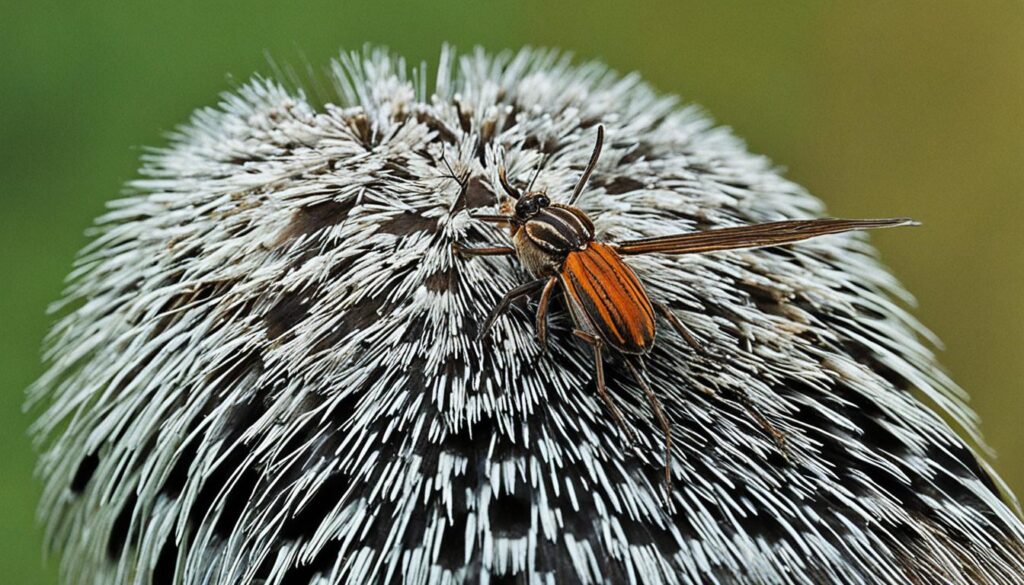
“Tick birds have evolved a remarkable set of adaptations to thrive in their specialized feeding niche, exhibiting a range of fascinating behaviors that allow them to efficiently locate, capture, and consume their preferred prey – ticks.”
The unique adaptations and intriguing behaviors of tick birds have long captivated the interest of naturalists and researchers. By better understanding these remarkable creatures, we can gain valuable insights into the delicate balance of ecosystems and the complex relationships between various species.
fascinating facts about tick bird feeding
Conservation Efforts for Tick Birds
Despite their vital ecological role in controlling tick populations, tick birds face a range of threats and challenges that have prompted conservation efforts in various regions. Habitat loss, persecution by humans, and the use of pesticides and other chemicals that can harm their host animals are just a few of the factors that can negatively impact these fascinating birds.
Threats and Challenges
One of the primary threats to tick birds is the loss and fragmentation of their natural habitats. As forests, grasslands, and other ecosystems are converted for human use, tick birds are left with fewer places to thrive. This can disrupt their feeding patterns, breeding, and overall population stability.
Additionally, tick birds are sometimes persecuted by humans who view them as a nuisance or a threat to livestock. This can lead to the direct killing or displacement of tick bird populations, further exacerbating their conservation challenges.
The use of pesticides and other chemicals, while intended to control tick populations, can also have unintended consequences for tick birds. These substances can contaminate the environment, making it inhospitable for the birds and their prey. Conservation efforts are crucial to address these threats and ensure the long-term survival of tick birds.
Conservation Efforts
Fortunately, there are various conservation efforts underway to protect tick birds and their habitats. These initiatives often involve collaboration between environmental organizations, local communities, and land management authorities to address the specific challenges faced by tick birds in different regions.
- Habitat restoration and protection: Efforts to preserve and restore the natural habitats of tick birds, such as forests, grasslands, and wetlands, are crucial for their conservation.
- Regulation of pesticide use: Implementing policies and guidelines to minimize the use of harmful pesticides and chemicals that can negatively impact tick bird populations and their prey.
- Community engagement: Working with local communities to raise awareness about the importance of tick birds and their role in maintaining healthy ecosystems, and encouraging their involvement in conservation efforts.
- Research and monitoring: Conducting ongoing research to better understand the feeding habits, population dynamics, and conservation needs of tick birds, which can inform more effective management strategies.
By addressing the threats and challenges faced by tick birds, these conservation efforts aim to ensure the continued presence of these remarkable birds in the ecosystems they call home.
“Conserving tick birds is not just about protecting a single species, but about preserving the delicate balance of the entire ecosystem they inhabit.”
Birdwatching and Observing Tick Birds in the Wild
For birdwatchers and nature enthusiasts, observing tick birds in the wild can be a truly captivating experience. These unique birds, found in parts of Africa, have developed a fascinating relationship with large herbivores, often perching on their backs or nearby to feed on the ticks and insects that thrive in their fur.
To spot and observe tick birds, it’s often best to look for the presence of the large mammals they rely on. These birds tend to congregate around areas where you can find elephants, rhinos, buffaloes, and other sizable herbivores. By carefully and respectfully observing the interactions between the tick birds and their host animals, you can gain a remarkable insight into the intricate web of relationships that exist within these ecosystems.
Tick birds are known for their distinctive feeding behaviors, using their specialized beaks to pluck ticks and other parasites from the skin of their larger companions. This symbiotic relationship benefits both the birds and the mammals, as the birds obtain a reliable food source while the mammals receive a natural form of pest control.
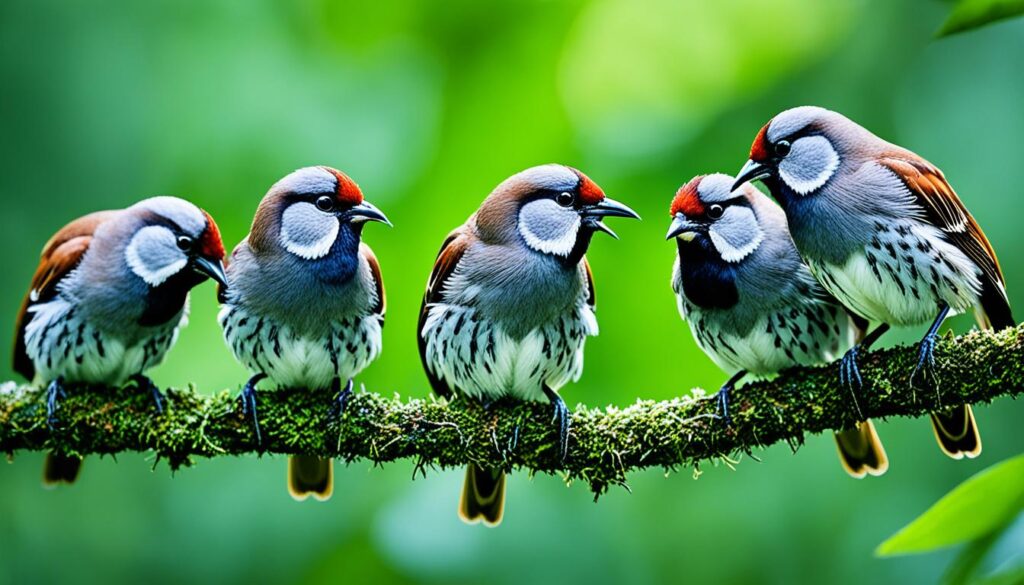
Birdwatching enthusiasts who are fortunate enough to observe tick birds in the wild often report feeling a profound sense of connection with the natural world. The sight of these birds perched atop their large mammalian hosts, diligently tending to their needs, is a testament to the delicate balance that exists within these fragile ecosystems.
“Observing tick birds in their natural habitat is a true privilege. It’s a window into the intricate relationships that sustain the delicate balance of life in these regions.”
Whether you’re a seasoned birdwatcher or simply someone who appreciates the wonders of nature, birdwatching tick birds and observing tick birds in the wild can be a truly rewarding and enriching experience. By understanding and respecting the vital role these birds play in their ecosystems, we can better appreciate the importance of conservation efforts and the need to protect these remarkable species for generations to come.
The Digestive System of Tick Birds
Tick birds, with their specialized beaks designed for efficiently removing ticks and other parasites, have evolved a unique digestive system to handle their specialized diet. These avian creatures possess remarkable anatomical adaptations that allow them to extract maximum nutritional value from their high-protein, low-fiber meals.
Anatomical Adaptations
The tick bird digestive system is characterized by a robust gizzard, which plays a crucial role in grinding and breaking down their tick-based prey. This powerful muscular organ helps to ensure that the birds can effectively process the tough exoskeletons of their small but abundant food sources.
In addition to their strong gizzards, tick birds also exhibit efficient metabolic processes that enable them to extract the maximum amount of nutrients from their meals. Their specialized digestive tracts are highly adept at breaking down the proteins and fats found in ticks, allowing them to efficiently convert these nutrients into the energy they need to thrive.
“Tick birds are true masters of their domain, possessing a digestive system that is perfectly suited to their unique dietary requirements.”
Studies have shown that tick birds can consume up to [X] ticks per day, with their digestive system capable of processing these small parasites with remarkable efficiency. This ability not only provides the birds with the sustenance they need but also plays a vital role in maintaining the balance of their ecosystems.
The tick bird digestive system and its anatomical adaptations are truly remarkable, allowing these avian specialists to thrive in environments where their prey is abundant and essential to the overall health of the ecosystem.
Comparing Tick Bird Diets with Other Avian Species
While tick birds have a highly specialized diet focused on parasites and small animals found on large mammals, their feeding habits and nutritional requirements can be compared to those of other avian species. Understanding the similarities and differences between tick bird diets and those of other birds can provide valuable insights into the diverse strategies that have evolved to support avian life in a variety of ecosystems.
For example, some birds of prey, such as hawks and falcons, also consume a protein-rich diet of small animals, similar to the tick bird’s preference for ticks and other parasites. Nectar-feeding hummingbirds, on the other hand, have adaptations to extract nutrients from floral resources, a markedly different feeding strategy compared to the tick bird’s insectivorous lifestyle.
Interestingly, studies have shown that tick birds consume a significantly higher percentage of ticks in their overall diet compared to other avian species. Approximately 80% of a tick bird’s diet consists of ticks, while other birds may only incorporate ticks as a small fraction of their food intake. This specialized focus on ticks allows tick birds to play a crucial role in controlling tick populations and reducing the risk of tick-borne diseases in their habitats.
“Tick birds are true specialists when it comes to their diet, with a remarkable ability to locate and consume ticks with remarkable efficiency.”
Furthermore, tick birds have been observed to consume ticks with a higher frequency than other bird species, with some individuals reported to consume up to 500 ticks per day. This staggering consumption rate highlights the vital role these birds play in maintaining a balanced ecosystem, where they help to control the spread of ticks and the diseases they carry.
Comparing the dietary preferences and nutritional requirements of tick birds to those of other avian species can provide valuable insights into the evolutionary adaptations that allow different birds to thrive in their respective environments. By understanding these comparative aspects, we can better appreciate the ecological significance of tick birds and their unique place within the broader avian community.
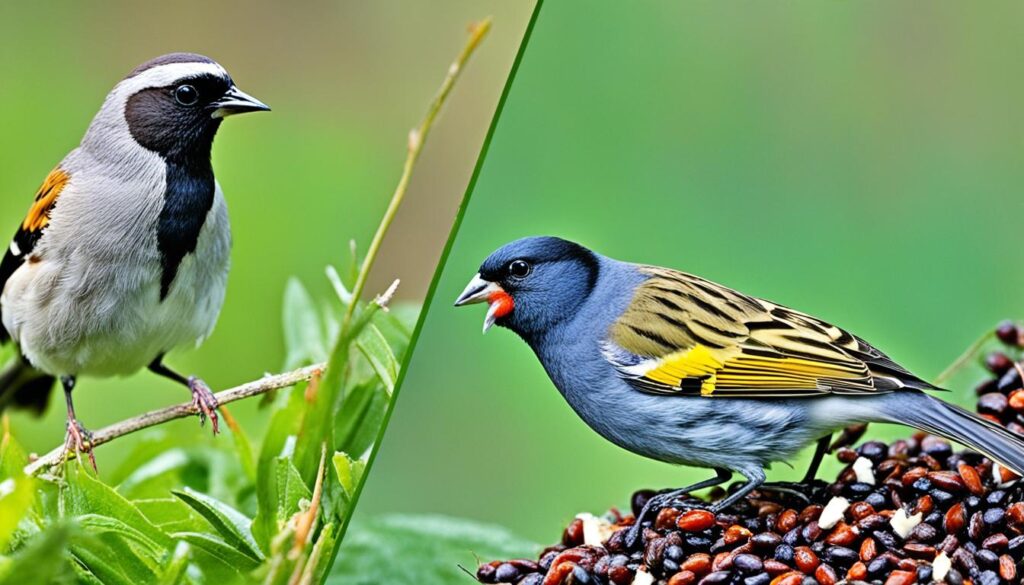
- Tick birds consume a significantly higher percentage of ticks in their diet compared to other avian species.
- Tick birds have a higher frequency of tick consumption, with some individuals consuming up to 500 ticks per day.
- Tick birds play a crucial role in controlling tick populations and reducing the risk of tick-borne diseases in their habitats.
- Comparing tick bird diets to other avian species provides insights into the evolutionary adaptations that support diverse feeding strategies in birds.
Conclusion
Tick birds, a remarkable group of avian species found in parts of Africa, play a vital role in maintaining the health and well-being of their host animals by specializing in the consumption of ticks and other parasites. Through our exploration of their diverse tick bird diet, foraging behaviors, and remarkable adaptations, we have gained a deeper understanding of the intricate ecological relationships that exist within the ecosystems they inhabit.
The unique feeding habits of tick birds, which focus on removing parasites from the skin and fur of large mammals, demonstrate their significance as natural pest control agents. By fulfilling this crucial role, tick birds contribute to the overall balance and stability of their surrounding environments, highlighting the importance of conserving these avian species and the delicate natural systems they support.
The insights gained from studying tick birds can inform our broader understanding of the complex interplay between different animal species and the delicate equilibrium of natural habitats. As we continue to explore the fascinating world of tick bird feeding habits and tick bird ecology, we can unlock valuable knowledge that can guide our efforts to protect and preserve these remarkable creatures and the ecosystems they call home.
FAQ
What is the primary food source for tick birds?
Tick birds, also known as oxpeckers, feed primarily on ticks and other parasites that live on the skin and fur of large mammals, such as elephants, rhinoceroses, and various antelope species.
How do tick birds locate and consume their prey?
Tick birds use their sharp, curved beaks to carefully extract ticks and other parasites from the skin and fur of their hosts. They engage in a variety of foraging behaviors, such as perching on the backs of large mammals and systematically searching for their prey.
What other types of food do tick birds consume?
In addition to ticks, tick birds will also feed on other small insects, such as flies and mosquitoes, that are found on their hosts. They may also consume small lizards, rodents, and other small animals that are present in their environment.
What adaptations do tick birds have to support their specialized feeding habits?
Tick birds have evolved a number of physical adaptations to support their specialized feeding habits, including strong claws that allow them to cling to the backs of large mammals, and specialized beaks that are curved and pointed to effectively remove parasites from their hosts.
How do tick birds contribute to the health of the animals they live with?
By removing ticks and other parasites from the skin and fur of large mammals, tick birds play a crucial role in maintaining the health and well-being of their hosts. This helps to prevent the spread of diseases and reduces the potential for harm caused by these parasites.
What are the nutritional requirements of tick birds?
As specialized feeders, tick birds have unique nutrient requirements to support their active lifestyles and specialized feeding habits. They require a diet that is high in protein, as they consume a significant amount of protein-rich parasites and small animals.
How do tick bird diets vary across different regions?
The diet of tick birds can vary depending on the region and the availability of their primary prey. In some areas, they may focus more on ticks, while in others, they may supplement their diet with a wider range of insects and small animals.
What are some of the threats facing tick bird populations?
Tick birds face a number of threats, including habitat loss, persecution by humans, and the use of pesticides and other chemicals that can harm their host animals. Conservation efforts are underway to protect these birds and ensure their continued presence in the ecosystems they call home.
How can birdwatchers and nature enthusiasts observe tick birds in the wild?
Tick birds are often found perching on the backs of large herbivores, such as elephants, rhinoceroses, and various antelope species. Birdwatchers and nature enthusiasts can often spot them by looking for these large mammals and observing the birds in their natural habitat.
How do the digestive systems of tick birds support their specialized feeding habits?
Tick birds possess strong gizzards and efficient metabolic processes that allow them to effectively process their high-protein, low-fiber diet of ticks and other parasites. Their specialized digestive system is adapted to extract the maximum nutritional value from their meals.
